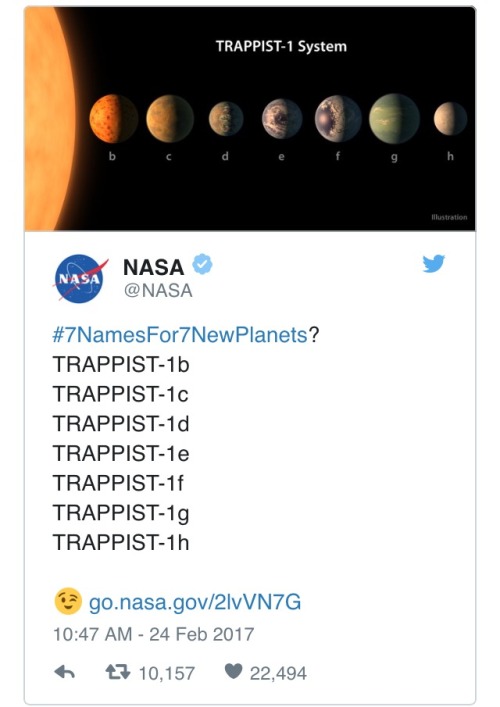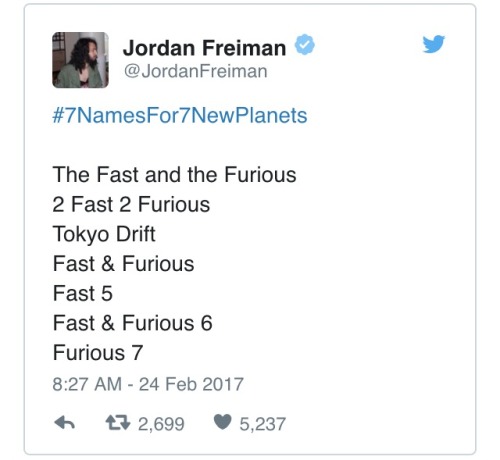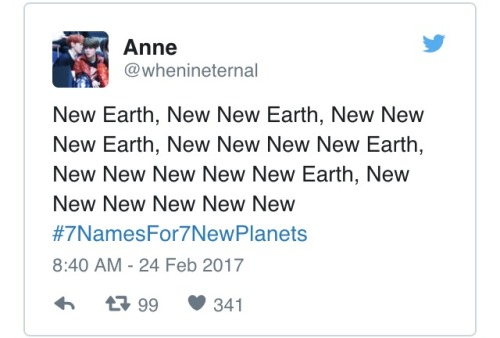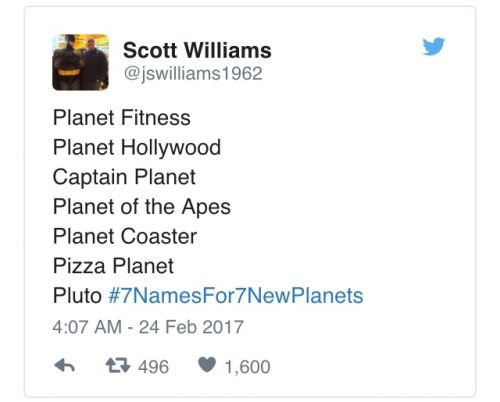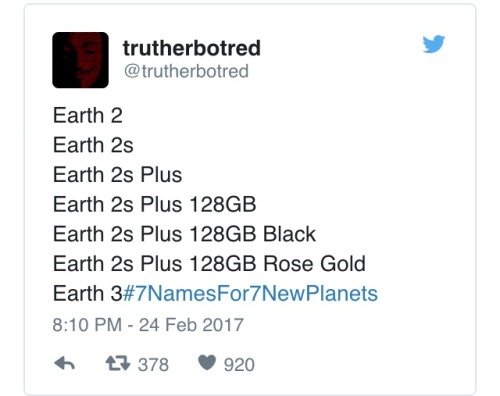Views Of Pluto Through The Years.

Views of Pluto Through the Years.
via reddit
More Posts from Fillthevoid-with-space and Others

The process of making an audio and visual compilation to explain Earth and humanity to an alien species is an incredible undertaking, and Carl Sagan undertook it in 1977. The resulting record from his little team was sent out with the Voyager 1 and 2 probes and is now in interstellar space, but there was also a more personal result of this project. Learn about Sagan and his third wife’s meet-cute and also hear what is actually out there in the stars, conveying the best humanity had to offer in the 70s.
Below the cut are my sources, music credits, a vocab list, and the transcript of this episode. Vote on what you think I should research next by messaging me here, tweeting at me at @HDandtheVoid, or asking me to my face if you know me in real life. And please subscribe to the podcast on iTunes, rate it and maybe review it, and tell friends if you think they’d like to listen!
(My thoughts on the next episode are space race history, the transit of Venus, Edmond Halley, or Dark Sky Preserves. Next episode will be up on December 4th.)
Glossary
electroencephalography (EEG) - a recording that displays brainwave activity by measuring the electrical impulses of neurons firing in the brain
heliosheath - the outer region of the heliosphere. It is just beyond termination shock, the point where solar wind abruptly slows down and becomes denser and hotter as it presses outward against the approaching wind in interstellar space.
heliosphere - a huge wind sock-shaped bubble that extends beyond Pluto’s orbit and contains our solar system, solar wind, and the entire solar magnetic field.
Transcript
Sources
Drunk History episode transcript
Golden record via NASA
Carl Sagan via Smithsonian Magazine, March 2014
Carl Sagan via Biography.com
Carl Sagan via National Geographic
The Voyager project love story via NASA
Ann Druyen: “We know that EEG patterns register some changes in thought. Would it be possible, I wondered, for a highly advanced technology of several million years from now to actually decipher human thoughts?"
Ann Druyen: "a mental itinerary of the ideas and individuals of history whose memory I hoped to perpetuate."
Ann Druyen: "My feelings as a 27-year-old woman, madly fallen in love, they're on that record. It's forever. It'll be true 100 million years from now. For me, Voyager is a kind of joy so powerful, it robs you of your fear of death."
Arthur C. Clarke: "Please leave me alone; let me go on to the stars."
How 8-track tapes work via 8 Track Heaven
How vinyl records work via The Guardian, June 2010
Golden record via Smithsonian Magazine, April 2012
Golden record via the JPL at NASA
Golden record retrospective by Timothy Ferris via The New Yorker, August 2017
Voyager Golden Record - Greetings In 55 Languages via YouTube
The 116 images NASA wants aliens to see via YouTube
The Voyagers documentary by Penny Lane via Brain Pickings
Ann Druyen: “Carl and I knew we were the beneficiaries of chance, that pure chance could be so kind that we could find one another in the vastness of space and the immensity of time. We knew that every moment should be cherished as the precious and unlikely coincidence that it was.”
Article on Sagan’s divorce from Linda Salzman Sagan via People, December 1980
Article on Sagan’s divorce from Linda Salzman Sagan via The Cornell Daily Sun, March 1981
Voyager record available on Soundcloud via Cosmos Magazine
Golden record now available for purchase via The Atlantic, August 2017
Intro Music: ‘Better Times Will Come’ by No Luck Club off their album Prosperity
Filler Music: ‘Dark Was The Night, Cold Was The Ground’ by Blind Willie Johnson (1897-1945) off the album Dark Was The Night ‘Carl Sagan’ by Loch Lomond off their album Paper The Walls
Outro Music: ‘Fields of Russia’ by Mutefish off their album On Draught
Asteroid to Fly Safely Past Earth on April 19
Asteroid Watch logo. April 7, 2017
Artist’s impression of a Near-Earth Asteroid passing by Earth. Image Credit: ESA
A relatively large near-Earth asteroid discovered nearly three years ago will fly safely past Earth on April 19 at a distance of about 1.1 million miles (1.8 million kilometers), or about 4.6 times the distance from Earth to the moon. Although there is no possibility for the asteroid to collide with our planet, this will be a very close approach for an asteroid of this size. The asteroid, known as 2014 JO25, was discovered in May 2014 by astronomers at the Catalina Sky Survey near Tucson, Arizona – a project of NASA’s NEO Observations Program in collaboration with the University of Arizona. (An NEO is a near-Earth object). Contemporary measurements by NASA’s NEOWISE mission indicate that the asteroid is roughly 2,000 feet (650 meters) in size, and that its surface is about twice as reflective as that of the moon. At this time very little else is known about the object’s physical properties, even though its trajectory is well known. The asteroid will approach Earth from the direction of the sun and will become visible in the night sky after April 19. It is predicted to brighten to about magnitude 11, when it could be visible in small optical telescopes for one or two nights before it fades as the distance from Earth rapidly increases.
Asteroid 2014 JO25
Video above: This computer-generated image depicts the flyby of asteroid 2014 JO25. The asteroid will safely fly past Earth on April 19 at a distance of about 1.1 million miles (1.8 million kilometers), or about 4.6 times the distance between Earth and the moon. Video Credits: NASA/JPL-Caltech. Small asteroids pass within this distance of Earth several times each week, but this upcoming close approach is the closest by any known asteroid of this size, or larger, since asteroid Toutatis, a 3.1-mile (five-kilometer) asteroid, which approached within about four lunar distances in September 2004. The next known encounter of an asteroid of comparable size will occur in 2027 when the half-mile-wide (800-meter-wide) asteroid 1999 AN10 will fly by at one lunar distance, about 236,000 miles (380,000 kilometers). The April 19 encounter provides an outstanding opportunity to study this asteroid, and astronomers plan to observe it with telescopes around the world to learn as much about it as possible. Radar observations are planned at NASA’s Goldstone Solar System Radar in California and the National Science Foundation’s Arecibo Observatory in Puerto Rico, and the resulting radar images could reveal surface details as small as a few meters. The encounter on April 19 is the closest this asteroid has come to Earth for at least the last 400 years and will be its closest approach for at least the next 500 years. Also on April 19, the comet PanSTARRS (C/2015 ER61) will make its closest approach to Earth, at a very safe distance of 109 million miles (175 million kilometers). A faint fuzzball in the sky when it was discovered in 2015 by the Pan-STARRS NEO survey team using a telescope on the summit of Haleakala, Hawaii, the comet has brightened considerably due to a recent outburst and is now visible in the dawn sky with binoculars or a small telescope. JPL manages and operates NASA’s Deep Space Network, including the Goldstone Solar System Radar, and hosts the Center for Near-Earth Object Studies for NASA’s Near-Earth Object Observations Program, an element of the Planetary Defense Coordination Office within the agency’s Science Mission Directorate. More information about asteroids and near-Earth objects can be found at: http://cneos.jpl.nasa.gov http://www.jpl.nasa.gov/asteroidwatch For more information about NASA’s Planetary Defense Coordination Office, visit: http://www.nasa.gov/planetarydefense For asteroid and comet news and updates, follow AsteroidWatch on Twitter: https://twitter.com/AsteroidWatch Image (mentioned), Video, Text, Credits: NASA/Tony Greicius/JPL/DC Agle. Greetings, Orbiter.ch Full article
What is an upcoming project/mission you're most excited for?
It is likely that I’ll be assigned a mission to the International Space Station (ISS) within the next few years. We’ve had a continuous presence on the Space Station for 17 years now, along with our international partners (Russian Space Agency, European Space Agency, Japanese Space Agency, and Canadian Space Agency). Missions on the ISS typically last 6 months. I’m incredibly excited to contribute to the impressive array of scientific experiments that we are conducting every day on ISS (I am a scientist after all!), and very much look forward to the potential of going for a spacewalk and gaining that perspective of gazing down on the fragile blue ball that is our home from above. Beyond that, being part of test missions on the Orion spacecraft (currently under construction at NASA!) would be an extraordinary opportunity. The current NASA plan is to send astronauts in Orion in a mission that will go 40,000 miles beyond the Moon in the early 2020s, reaching a distance further than that ever travelled by humans. I’d certainly be game for that!


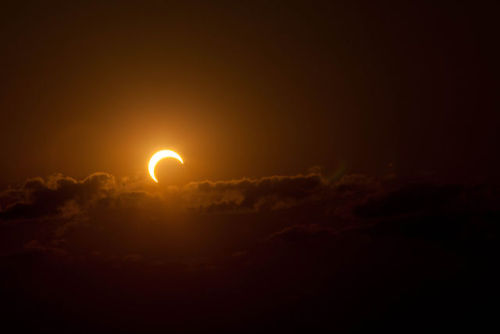

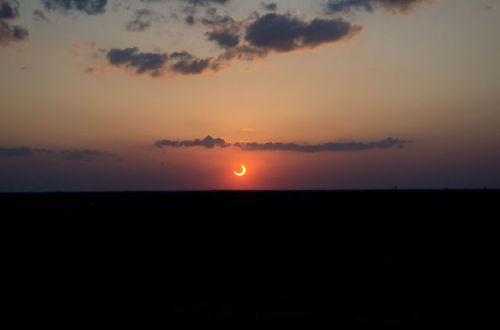


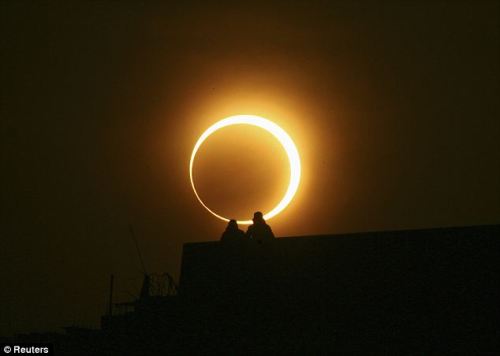
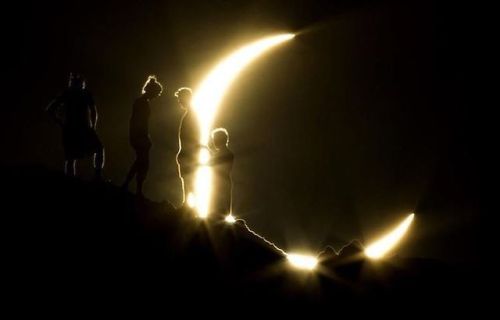
A ‘Ring of Fire’ solar eclipse is a rare phenomenon that occurs when the moon’s orbit is at its apogee: the part of its orbit farthest away from the Earth. Because the moon is so far away, it seems smaller than normal to the human eye. The result is that the moon doesn't entirely block out our view of the sun, but leaves an “annulus,” or ring of sunlight glowing around it. Hence the term “annular” eclipse rather than a “total” eclipse.

When I was in Ireland in 2013, I kept seeing signs for ‘quasar.’ I finally learned that it’s the European way of saying laser tag. It has nothing to do with quasars, which are a specific type of a specific type of galaxy. Listen to this week’s (pretty short) podcast on two types of active galaxies: quasars and blazars.
Below the cut, I have the transcript, sources, music credits, and timeline of people I talked about! If you have suggestions for topics I could cover, please send me a Tumblr message or tweet at me on Twitter at @HDandtheVoid, or you can ask me to my face if you know me. Please subscribe on iTunes, rate my podcast and maybe review it, and tell friends if you think they’d like to hear it!
(My thoughts on the next episode are the SOFIA observatory, Chuck Yaeger, or the great Stephen Hawking. The next episode will go up April 2nd.)
Glossary
active galaxy or active galactic nucleus- a galaxy with a small core of emission embedded at the center. This core is typically very variable and very bright compared to the rest of the galaxy. These galaxies emit much more energy than they should; this excess energy is found in the infrared, radio, UV, and X-ray regions of the electromagnetic spectrum.
blazar - a subcategory of active galaxy, it is an extremely bright, distant object, powered by a black hole, which emits massive amounts of energy. It is distinct from a quasar because it is even brighter.
extragalactic objects - objects outside our Milky Way galaxy.
interferometry - a group of techniques to extract information from superimposing electromagnetic waves to create interference. In radio astronomy, this is done by using a wide spread of receivers to look at the same distant object, then bringing that data together with a correlator that can create a larger, clearer picture than an individual radio telescope alone could.
lunar occultations - when stars pass behind the Moon. This is the basis for a method of determining and mapping star positions.
quasar - a subcategory of active galaxy, it is an extremely bright, distant object, powered by a black hole, which emits massive amounts of energy. It is distinct from a blazar because it is less-bright. The name is a contraction of “quasi-stellar radio source” (which is not necessarily true of all quasars—90% are radio-quiet).
torus - a donut shape.
Script/Transcript
Timeline
Walter Baade, German (1893-1960)
Rudolph Minkowski, German-American (1895-1976)
Fritz Zwicky, Swiss (1898-1974)
Gordon Stanley, New Zealander (1921-2001)
John Bolton, English-Australian (1922-1993)
Owen Bruce Slee, Australian (1924-2016)
Allan Rex Sandage, American (1926-2010)
Cyril Hazard, English (1928- )
Maartin Schmidt, Dutch (1929- )
Hong-Yee Chiu, American (1932- )
Stephen Hawking, English (1942 -2018)
Jedidah Isler
Sources
Active Galaxies via NASA (Dec 2016)
Galaxy shapes via Cornell University (April 2000)
Galaxies and Black Holes by David Merritt, published on NED by Caltech and NASA
Cyril Hazard via University of Pittsburgh
The Discovery of Quasars and its Aftermath via Journal of Astronomical History and Heritage (2014)
“Characteristically, Fritz Zwicky (1898–1974; Figure 11) immediately pointed out that ‘All of the five quasi-stellar galaxies described individually by Sandage (1965) evidently belong to the subclass of compact galaxies with pure emission spectra previously discovered and described by the present writer. (Zwicky, 1965: 1293).’ A few years later, Zwicky was less circumspect and wrote: ‘In spite of all these facts being known to him in 1964, Sandage attempted one of the most astounding feats of plagiarism by announcing the existence of a major new component of the Universe: the quasi-stellar galaxies ... Sandage‘s earthshaking discovery consisted in nothing more than renaming compact galaxies, calling them ‘interlopers‘ and quasistellar galaxies, thus playing the interloper himself. (Zwicky and Zwicky, 1971: xix)’”
Lunar occultations via Sky and Telescope
Quasars and Blazars by Matthew Whiting (a chapter in his thesis, What made the quasar blush? Emission mechanisms in optically-red quasars) via the Australia Telescope National Facility (2000)
Jedidah Isler on quasars and blazars via TED Talks (March 2015)
Quasar definition via Space.com (Feb 2018)
Intro Music: ‘Better Times Will Come’ by No Luck Club off their album Prosperity
Filler Music: ‘Into The White’ by Pixies off their album Wave of Mutilation.
Outro Music: ‘Fields of Russia’ by Mutefish off their album On Draught
Ongoing Space Science Seeks to Keep Astronauts Healthy
ISS - Expedition 50 Mission patch. March 10, 2017 NASA is preparing for longer human journeys deeper into space and is exploring how to keep astronauts healthy and productive. The Expedition 50 crew members today studied space nutrition, measured their bodies and checked their eyes to learn how to adapt to living in space. The space residents also unloaded a cargo ship, worked on the Tranquility module and practiced an emergency simulation. The ongoing Energy experiment that ESA astronaut Thomas Pesquet collected urine samples for today seeks to define the energy requirements necessary to keep an astronaut successful during a space mission. Pesquet also joined NASA astronaut Peggy Whitson for body measurements to learn how microgravity affects body shape and impacts crew suit sizing. Commander Shane Kimbrough checked his eyes today with Whitson’s help and support from experts on the ground.
Image above: Astronaut Shane Kimbrough and Thomas Pesquet were pictured inside the cupola just after the SpaceX Dragon was captured Feb. 23, 2017. Image Credit: NASA. Kimbrough worked throughout the day before his eye checks and configured the Tranquility module for upcoming electronics and communications work. Cosmonaut Oleg Novitskiy continued unloading gear from the newly-arrived Progress 66 cargo ship. At the end of the day, Novitskiy joined Whitson and Pesquet for an emergency simulation with inputs from control centers in Houston and Moscow. Related links: Energy experiment: https://www.nasa.gov/mission_pages/station/research/experiments/397.html Body measurements: https://www.nasa.gov/mission_pages/station/research/experiments/1070.html Space Station Research and Technology: https://www.nasa.gov/mission_pages/station/research/index.html International Space Station (ISS): https://www.nasa.gov/mission_pages/station/main/index.html Image (mentioned), Text, Credits: NASA/Mark Garcia. Best regards, Orbiter.ch Full article

Light Echoes Used to Study Protoplanetary Disks : This illustration shows a star surrounded by a protoplanetary disk. A new study uses data from NASAs Spitzer Space Telescope and four ground-based telescopes to determine the distance from a star to the inner rim of its surrounding protoplanetary disk. Researchers used a method called photo-reverberation, also known as light echoes.
js
Tampons were packed with their strings connecting them, like a strip of sausages, so they wouldn’t float away. Engineers asked Ride, “Is 100 the right number?” She would be in space for a week. “That would not be the right number,” she told them. At every turn, her difference was made clear to her. When it was announced Ride had been named to a space flight mission, her shuttle commander, Bob Crippen, who became a lifelong friend and colleague, introduced her as “undoubtedly the prettiest member of the crew.” At another press event, a reporter asked Ride how she would react to a problem on the shuttle: “Do you weep?”
Astronaut Sally Ride and the Burden of Being “The First” (via dinosaurparty)
-
 gochena liked this · 6 years ago
gochena liked this · 6 years ago -
 mostly-stimssssssss reblogged this · 6 years ago
mostly-stimssssssss reblogged this · 6 years ago -
 h-b-o-m-b liked this · 6 years ago
h-b-o-m-b liked this · 6 years ago -
 hueonconchetumare reblogged this · 6 years ago
hueonconchetumare reblogged this · 6 years ago -
 rdhdlvr liked this · 6 years ago
rdhdlvr liked this · 6 years ago -
 lethendralis-paints liked this · 6 years ago
lethendralis-paints liked this · 6 years ago -
 daemondamian liked this · 6 years ago
daemondamian liked this · 6 years ago -
 arcyra reblogged this · 6 years ago
arcyra reblogged this · 6 years ago -
 verminviscount liked this · 6 years ago
verminviscount liked this · 6 years ago -
 im-still-breathing-roses liked this · 6 years ago
im-still-breathing-roses liked this · 6 years ago -
 mostly-stimssssssss liked this · 6 years ago
mostly-stimssssssss liked this · 6 years ago -
 jamesteamrocket22 reblogged this · 6 years ago
jamesteamrocket22 reblogged this · 6 years ago -
 jamesteamrocket22 liked this · 6 years ago
jamesteamrocket22 liked this · 6 years ago -
 kinokochouchou reblogged this · 6 years ago
kinokochouchou reblogged this · 6 years ago -
 kinokochouchou liked this · 6 years ago
kinokochouchou liked this · 6 years ago -
 thought-ripples liked this · 6 years ago
thought-ripples liked this · 6 years ago -
 risiskifi reblogged this · 6 years ago
risiskifi reblogged this · 6 years ago -
 risiskifi liked this · 6 years ago
risiskifi liked this · 6 years ago -
 mandoblando liked this · 6 years ago
mandoblando liked this · 6 years ago -
 krimzonimprexx32moonchild-a-blog reblogged this · 6 years ago
krimzonimprexx32moonchild-a-blog reblogged this · 6 years ago -
 p0tat0pal liked this · 6 years ago
p0tat0pal liked this · 6 years ago -
 thatlonelyintrovert liked this · 6 years ago
thatlonelyintrovert liked this · 6 years ago -
 almostperfectwizard reblogged this · 6 years ago
almostperfectwizard reblogged this · 6 years ago -
 almostperfectwizard liked this · 6 years ago
almostperfectwizard liked this · 6 years ago -
 king-of-the-rain-and-wolves liked this · 6 years ago
king-of-the-rain-and-wolves liked this · 6 years ago -
 lucillaenchantress liked this · 6 years ago
lucillaenchantress liked this · 6 years ago -
 sublimeaxolotls liked this · 6 years ago
sublimeaxolotls liked this · 6 years ago -
 delightfully-anonymous liked this · 6 years ago
delightfully-anonymous liked this · 6 years ago -
 whisperersworld reblogged this · 6 years ago
whisperersworld reblogged this · 6 years ago -
 whisperersworld liked this · 6 years ago
whisperersworld liked this · 6 years ago -
 harmonic-psyche liked this · 6 years ago
harmonic-psyche liked this · 6 years ago -
 thrvsersworld reblogged this · 6 years ago
thrvsersworld reblogged this · 6 years ago -
 kipkipkepler liked this · 6 years ago
kipkipkepler liked this · 6 years ago -
 musicopia liked this · 6 years ago
musicopia liked this · 6 years ago -
 onethirdofmysoul reblogged this · 6 years ago
onethirdofmysoul reblogged this · 6 years ago -
 visiting-alien liked this · 6 years ago
visiting-alien liked this · 6 years ago -
 echelongaga liked this · 6 years ago
echelongaga liked this · 6 years ago -
 atimelordfromkrypton reblogged this · 6 years ago
atimelordfromkrypton reblogged this · 6 years ago -
 xnightwalkerxx liked this · 6 years ago
xnightwalkerxx liked this · 6 years ago -
 cnovakw liked this · 7 years ago
cnovakw liked this · 7 years ago -
 aimlessandroiddreamer reblogged this · 7 years ago
aimlessandroiddreamer reblogged this · 7 years ago
A podcast project to fill the space in my heart and my time that used to be filled with academic research. In 2018, that space gets filled with... MORE SPACE! Cheerfully researched, painstakingly edited, informal as hell, definitely worth everyone's time.
243 posts
